History of the Arkansas Democrat-Gazette
Democrat-Gazette history | Palmer-Hussman family history | Statement of core values
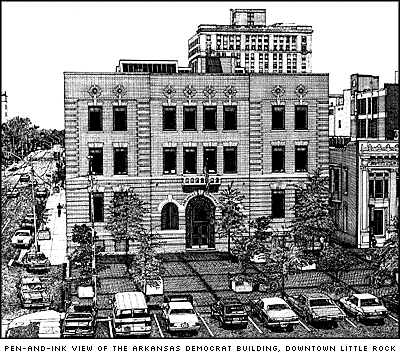
Arkansas' past entwined with newspaper's vivid story
The history of Arkansas' newspaper, the Arkansas Democrat-Gazette, begins in the wilderness at Arkansas Post.
At a clearing in those dense woods the Arkansas Gazette was born in 1819, at a simple frontier time when Arkansas was still a young territory, not yet a state.
Half a century later the Arkansas Democrat came into being, born of the turbulent politics of the defeated, war-ruined South.
Together they dominated the newspaper landscape of Arkansas for more than a century. Today they survive and thrive as one -- the oldest continuously published newspaper west of the Mississippi
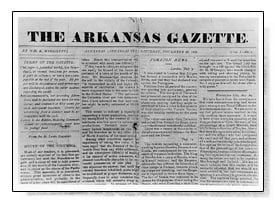 The front page of the Gazette from 1819.
The front page of the Gazette from 1819.
The first days of the Arkansas Democrat-Gazette go back to the moment when William E. Woodruff, the young founder of the Arkansas Gazette, landed at Arkansas Post accompanied by his printing press. He had made an arduous journey in flatboats down the Cumberland, Ohio, and Mississippi Rivers, changing to a dugout canoe for the final upstream leg to the rustic capital of the new territory.
Soon after Woodruff's arrival, the first territorial Legislature met. There was an abundance of news and official business to be printed.
Woodruff's training and equipment were up to date and up to the task. As Henry Bullen wrote in the Gazette's centennial edition in 1919: "There were larger plants in New York City, but the presses and types they used were of exactly the same style and size as the press and types used by . . . William E. Woodruff in Arkansas Post in 1819."
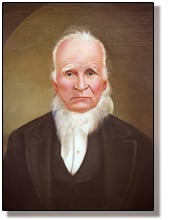 Portrait of William E. Woodruff
Portrait of William E. Woodruff
After two years in the humid, mosquito-infested village, Woodruff moved his Gazette to Little Rock in 1821, following the relocation of the territorial capital there. Through the pages of his newspaper he worked tirelessly to promote new settlement in Arkansas. By 1836, when Arkansas gained the statehood for which the Gazette had energetically campaigned, its population exceeded 50,000. Woodruff could boast of 1,800 Gazette subscribers and $30,000 in advertising, subscription and printing debts owed to him.
Consistent with the regional enthusiasms of the day, the Gazette campaigned for Texas independence from Mexico and, in turn, annexation to the United States.
It supported the Mexican War (1846-48), adding its voice to the call for volunteers from Arkansas.
The 1840s in Arkansas were a time of wild financial speculation followed by a hard crash, and the Gazette's finances suffered along with those of the state.
Starting in 1836, the Gazette went through a series of changes leading to co-partnerships and three sales to other owners. In 1850, Woodruff repurchased it; but meanwhile, in 1846, he had established a competing newspaper which he called the Arkansas Democrat. During the 1850s Woodruff's two papers were united under the name Arkansas State Gazette and Democrat, but in 1859 he simplified that to Arkansas State Gazette, echoing the one he had chosen more than 40 years before.
When Union soldiers captured Little Rock on Sept. 10, 1863, the Gazette suspended publication, remaining silent until May 1865. Federal authorities commandeered its presses and used them for their own purposes.
Woodruff's short-lived Arkansas Democrat has no direct connection to today's Arkansas Democrat-Gazette. A different Arkansas Democrat arose during Reconstruction and its aftermath. First called The Liberal, then The Journal, then The Chronicle, and finally The Evening Star, the newspaper had passed through several hands and several editors by 1875.
Then, on April 11, 1878, Col. J.N. Smithee, an Arkansan who had served in the Confederate Army, acquired the newspaper, named it the Arkansas Democrat, and took aim on the state's lucrative printing contracts.
He also immediately launched an attack upon the Gazette over the issue of the repudiation of the state debt. The Gazette struck back, implying that the name Democrat was merely a cover for a resurgent Republican Party.
Later that year Smithee engaged in a shoot-out at the corner of Markham and Main streets in Little Rock with Maj. John A. Adams, a part-owner of the Gazette.
Neither man was wounded seriously, although Smithee was hit by two bullets. But soon Smithee was compelled to dispose of his newspaper when the board of printing commissioners implicated him in a conflict of interest because of his other job as state land commissioner. In September 1878, former Arkansas Gazette editor James Mitchell and his partner Gen. W.D. Blocher, former owner of the Gazette, bought the Democrat from Smithee.
In a remarkable twist of fate suggesting how inbred the newspaper business must have been during this era, the controversial Smithee was named president of the Arkansas Gazette a few years later.
During Mitchell's first year with the Arkansas Democrat, he successfully backed J.D. Walker for Congress against R.W. Johnson, who happened to be the brother of the editor of the Arkansas Gazette. This was perceived as a great victory for the Democrat and increased its business immensely.
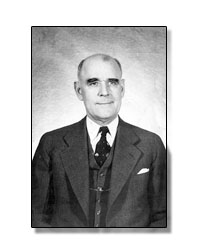 K. August Engel,
K. August Engel,President and General Manager of the Democrat
In the 20th century, both newspapers came under the dominance of two men -- J.N. Heiskell at the Gazette, and K. August Engel at the Democrat.
After James Mitchell died in 1902, the ownership of the Democrat changed hands three times. In 1926, K. August Engel, who had been born in Luckenbach, Texas, in 1889, and who had joined the Democrat as business manager in 1911, acquired a major interest and became the newspaper's president and general manager.
Engel controlled the paper for the next 42 years, leading it through a period of great growth. In 1930 he acquired the YMCA building at Capitol Avenue and Scott Street and turned it into a modern newspaper plant. He gained a reputation as a hard-working, shrewd businessman who insisted on running his business on a cash basis. A bachelor, he lived in a hotel a few blocks from the Democrat building.
He took an active part in the editorial process, even to the point of reviewing proofs of editorials and news pages.
Under Engel, the Democrat urged reforms at the state hospital, improved election laws, revision of property tax assessments, municipal ownership of city waterworks, improved education and a four-year college for Little Rock.
In 1954, the University of Arkansas at Fayetteville awarded Engel an honorary degree, stating: "You have kept free the news columns of the Arkansas Democrat that they might report in an objective manner the events of the world . . . you have been a faithful watchman for the people and the public good."
Engel died on Jan. 8, 1968. His nephews, Marcus George and C.S. Berry, were appointed editor and publisher, respectively. The Gazette had this to say about Engel the day after his death: "Except for its occasional ventures in sensational, topical news articles -- a penchant shared by most afternoon newspapers -- the Democrat during Engel's tenure was austere in its makeup and treatment of general news."
The first half of the 20th century also saw the Gazette consolidating leadership that would carry it to a position of eminence. In 1902, the Gazette Publishing Co. was reorganized and John Netherland Heiskell, a Tennessean by birth, became president and editor-in-chief. He held these positions for 70 years until his death in 1972 at the age of 100. When Heiskell bought the Gazette, its circulation was about 6,000; when he died, it was more than 100,000.
The Gazette's circulation had reached 100,000 in the 1950s, then dipped to 83,000 because of its editorial policy during the 1957 integration crisis in Little Rock. The Gazette took a strong editorial stand against Gov. Orval E. Faubus' attempts to prevent integration of Central High School. The Gazette was awarded two Pulitzer Prizes in 1958 -- one for meritorious public service and the other to its executive editor, Harry Ashmore, for editorial writing.
Long before 1957, a highlight of Heiskell's career had been his sustained opposition to Jeff Davis, a turn-of-the-century Arkansas governor and United States senator. The colorful Davis, a stem-winding stump speaker who was unrelated to the Confederate president of the same name, often attacked both Little Rock newspapers. On one occasion he said, "I see the Gazette agent out there in the audience giving out that old red harlot, the Arkansas Gazette. I had rather be caught with a dead buzzard under my arm, or a dead polecat." Another time he regaled his listeners with a story about his young son: "If I find that boy is a smart boy, I will go and make a preacher out of him; if I find he is not so smart a boy, I am going to make a lawyer out of him; if I find he has not a bit of sense upon earth, I am going to make an editor out of him and send him to Little Rock to edit the Arkansas Democrat."
When Davis died suddenly in 1913, Heiskell, in a sweet bit of irony, was appointed by Gov. George Donaghey to fill his old rival's vacant Senate seat. Heiskell's term lasted only three weeks, so his maiden Senate speech was also his farewell speech. "Maybe we should have more of that in the Senate," said Heiskell, who gained a reputation as a wit through the years.
A few months before Heiskell's death in 1972, the Gazette opened a new production building at Fourth and Byrd streets in Little Rock. The architecturally notable Gazette building at Third and Louisiana had also been erected during Heiskell's tenure as editor, being dedicated in 1908.
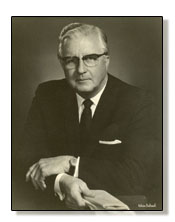 Hugh B. Patterson became publisher of theGazette in 1948.
Hugh B. Patterson became publisher of theGazette in 1948.
Hugh B. Patterson, J.N. Heiskell's son-in-law, who had been the Gazette's business manager, became publisher in 1948. He was elected president of the company in 1970.
Soon afterward, change came to the Democrat. In 1974 Marcus George and C.S. Berry sold the newspaper for $3.7 million to the Palmer group, headed by Walter E. Hussman. His son, 27-year-old Walter E. Hussman Jr., became the Democrat's new publisher.
What happened in Little Rock in the next several years mirrored trends in the newspaper industry all across the country. Five hundred cities had boasted separately owned, competing newspapers in 1923. By 1953 only 90 cities did. By 1974, when the Palmer group purchased the Democrat, such competition survived in just 34 cities.
At the start of the 1960s, the two Little Rock newspapers had been neck-and-neck in circulation. In the first quarter of 1960, the Democrat's daily circulation was 88,890, narrowly ahead of the Gazette's 88,152. Owners of the two newspapers on numerous occasions discussed a joint printing plant, but plans always fell through because of disagreements over where to locate the plant and because of the impossibility of printing both Sunday newspapers.
Most of the newspapers that were dying off in America were circulated in the afternoon. Reflecting this trend, circulation at the Democrat declined substantially throughout the 1960s and 1970s.
By 1974, the numbers were stark: Gazette circulation was 118,702; Democrat circulation was 62,405. In addition, the Democrat had only about a fourth of the total newspaper revenue in the market.
For three years after 1974, the Hussmans responded by pursuing a strategy of reducing operating costs and focusing subscription efforts in the city zone.
This effort was not enough to reverse circulation and advertising trends, so in 1977 Walter E. Hussman Jr. sought a joint operating agreement with the Gazette. Both the specific offer and the basic concept of a joint operating agreement were rejected by Hugh Patterson at the Gazette.
Hussman concluded he had two options: Either to close the Democrat or to make a commitment to vigorous competition.
He chose the latter. A hotly competitive 13-year newspaper war ensued.
In late 1978, the Democrat began an extensive effort to expand its news and classified advertising in order to become the state's largest newspaper.
Included was a free want ad program that more than tripled the size of the paper's classified section. The Democrat became the only Arkansas newspaper ever to publish more than one million classified advertisements in a single year.
In 1979, the Democrat switched to all-morning publication -- one of the first newspapers of its size to do so. The transition was done in steps. In January, the paper began publishing a morning edition seven days a week in addition to its evening papers. This late deadline morning paper was initially only for circulation outside Pulaski County. The Democrat published its last evening editions on Oct. 7.
Since then, the number of afternoon newspapers has declined by 432, while the number of morning newspapers has increased by 234. In 1980 there was more afternoon circulation than morning circulation for American newspapers but today there is 2.5 times as much morning as afternoon circulation.
Also in 1979, John Robert Starr, former Arkansas bureau chief of the Associated Press, became managing editor of the Democrat. The news staff was doubled in size and the news space increased more than 50 percent.
As a result of these vigorous new policies, readership increased dramatically.
Circulation totals showed that the Democrat was the fastest growing newspaper in the United States during 1980.
Across town at the Arkansas Gazette, 1981 saw big changes too. Robert R. Douglas, Gazette managing editor since 1972, announced his resignation in July and was named chairman of the department of journalism at the University of Arkansas. Hugh Patterson remained as publisher while his son, Carrick H. Patterson, was named the Gazette's managing editor.
At the Democrat, the changes continued. Dozens of new reporters, editors and photographers had been hired in an effort to ensure the most thorough local news coverage possible. In 1982 the newspaper inaugurated the use of color, using offset lithography printing presses; the Gazette followed in 1987.
Two other significant developments that would affect the course of the competition occurred in the 1980s. First, the Gazette filed a federal antitrust suit against the Democrat in 1984. Second, the Gannett Corp., the nation's largest newspaper chain, bought the Gazette in 1986.
The suit accused the Hussman enterprises of trying to put the Gazette out of business. The Democrat responded that it was only trying to remain competitive, and that none of its practices were intended to run the Gazette out of business.
A federal jury in the court of U.S. District Judge William R. Overton rendered its verdict on March 26, 1986. The Democrat was found innocent of all the allegations leveled against it by the Gazette.
Just a few months later, on Oct. 30, the newspaper war's biggest bomb was dropped: Gannett was coming to Little Rock. The Heiskell-Patterson family sold the Arkansas Gazette to Gannett on Dec. 1, 1986.
Wehco Media Inc., the parent company of the Arkansas Democrat, was the largest media company in Arkansas. But Gannett was the largest in the country. Wehco's annual revenues at the time were about $60 million; Gannett's were $2 billion.
Gannett also acquired a built-in daily circulation lead when it arrived in Little Rock: 131,020 for the Gazette, 78,302 for the Democrat.
Within five years the Democrat had closed the gap: Gazette daily circulation was 134,027; the Democrat's, 133,753. On Sunday the Democrat was substantially ahead, 241,361 to 225,326.
Each year, Gannett was suffering increased financial losses with the Gazette, with losses of more than $29 million in its last year of ownership.
Throwing in the towel, Gannett closed the Gazette after publishing a final edition on Oct. 18, 1991. Later that day the Democrat purchased all the assets, including the subscription list of the Gazette, and renamed the combined newspaper the Arkansas Democrat-Gazette the next day.
"We survived the greatest competitive onslaught in the newspaper business," Hussman said at the time.
Since the Gazette closed in 1991, competing newspapers have also closed in Dallas, Pittsburgh, San Antonio and Tulsa, further reducing the short list of competitive newspaper cities in America. In April 1992, Paul Greenberg, the Pulitzer Prize winning writer from Pine Bluff, was chosen to be the Democrat-Gazette's editorial page editor.
On June 23, 1992, less than a year after the long newspaper war ended, John Robert Starr retired as managing editor of the Democrat-Gazette and Griffin Smith, jr., was named executive editor. One week later Smith appointed Robert Lutgen to be the newspaper's managing editor. Lutgen was succeded as Managing Editor by David Bailey, who was promoted from City Editor, on Dec. 23, 1998.
In December 2010, the Arkansas Democrat-Gazette launched an iPad app offering an exact digital replica of the printed edition of the newspaper. In 2019, the paper converted to a digital model where the newspaper is delivered daily to the iPad app and home-delivered on Sundays with subscribers having the option to receive an iPad to use as part of their subscription. Users of the app also have access to the top headlines updated throughout the day as well as push alerts to notify users of top stories.